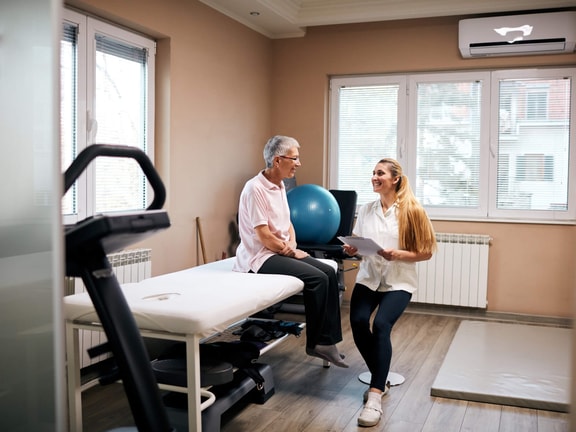FOTO Scores in Rehab: Driving Better Outcomes and Smarter Decisions
Improve patient outcomes and streamline rehab care with FOTO scores. Learn how to engage patients, guide decisions, and boost clinic performance.
June 20, 2025
8 min. read

FOTO scores (Focus on Therapeutic Outcomes) are standardized, risk-adjusted patient-reported outcome measures (PROMs) used in rehabilitation to evaluate functional improvement, care effectiveness, and treatment efficiency. These scores offer clinicians and care teams clear, objective insights to guide decision-making and demonstrate the value of therapy.
In outpatient rehabilitation, clinicians and organizations often face a familiar challenge: patient retention. Many patients who don’t see early progress disengage before completing their care plan, often without notifying their provider. An estimated 20 percent discontinue therapy early, which can compromise outcomes and contribute to lost revenue.1 As healthcare systems increasingly emphasize outcomes and accountability, having reliable tools to measure progress and drive engagement is more important than ever.
This article explores what FOTO scores are, why they matter in modern rehab, and how they can be used to improve both clinical outcomes and operational performance. We’ll also examine how organizations can combine FOTO with digital care tools to achieve measurable gains.
What are FOTO scores and why do they matter?
FOTO is a comprehensive outcomes measurement system that equips rehabilitation professionals and organizations with data-driven insights into patient performance. It’s condition-specific, allowing therapists to select outcome measures tailored to the patient’s diagnosis and the body region being treated, ensuring relevance and accuracy in functional assessment. FOTO produces standardized scores in three areas:
Effectiveness: Measures how much functional improvement a patient makes over the course of care.
Efficiency: Assesses how quickly those improvements occur, typically by tracking the number of visits per episode.
Patient satisfaction: Captures the patient’s perspective on their care experience.
FOTO scores are captured at key milestones in the rehab journey:
Initial functional status: Captured at intake, this PROM assesses the patient’s baseline ability related to the affected body part or condition.
Predicted goal status: Established using FOTO’s proprietary risk adjustment model (which accounted for 10+ factors, including age, diagnosis, and comorbidities), this score provides a personalized benchmark for expected improvement.
Discharge functional status: Measured at the end of care, this PROM evaluates final functional ability and is compared with the initial score to assess actual treatment effectiveness.
Unlike traditional outcome tracking tools, FOTO applies rigorous national risk adjustment to ensure fairness and comparability across patient populations. The goal is to create a level playing field for comparison. The result? Clinicians and care teams gain a fair, evidence-based framework to evaluate performance, improve care planning, and engage patients in meaningful conversations about their progress.
FOTO’s predictive model draws from a robust national database, enabling clinicians to set realistic, risk-adjusted goals tailored to each patient’s profile. These goals are benchmarked against outcomes for patients with similar demographics and clinical presentations, offering a transparent and accountable framework for evaluating performance. This level of national comparability guides individualized care and supports clinic-wide quality initiatives.
Benefits of using FOTO scores in your practice
Whether you’re providing direct care, managing a team, or driving clinic-wide quality initiatives, FOTO scores can be a powerful asset. By integrating these outcomes into routine workflows, clinicians and organizations alike can make smarter decisions, engage patients more effectively, and support sustainable growth.
1. Improving patient outcomes
FOTO scores give care teams clear, real-time insight into patient progress. Consistent outcome tracking allows for early identification of plateaus or setbacks, enabling more personalized interventions. This supports faster recovery, fewer unnecessary visits, and better overall results.
2. Strengthening patient engagement
When clinicians share FOTO results with patients, it promotes transparency and fosters trust. Seeing measurable progress can motivate patients to stay engaged throughout their care plan. This kind of collaboration supports stronger therapeutic alliances and can lead to better outcomes, as studies have shown that higher patient activation is linked to improved clinical results and greater satisfaction.2
3. Demonstrating value to payers and referrers
Objective outcomes data from FOTO can support payer reporting, satisfy quality metrics, and help strengthen referral relationships by clearly communicating your clinic’s effectiveness and accountability. FOTO data can also support participation in value-based care programs such as the Merit-Based Incentive Payment System (MIPS) and Alternative Payment Models (APMs) by providing standardized, risk-adjusted evidence of clinical effectiveness.
4. Driving business growth and clinical insight
Higher FOTO scores are often linked to stronger patient retention and full episode completion, both of which are critical drivers of revenue. FOTO’s benchmarking tools also enable performance comparisons across clinicians or sites, helping leadership identify high performers, streamline processes, and guide staff development.
Real-world results: How CORA Health Services boosted FOTO scores
CORA Health Services is a top-10 national provider of outpatient therapy, with more than 250 clinics across 10 states. Like many organizations in the rehab space, CORA was looking for ways to keep patients engaged throughout their full episode of care. Early drop-off can compromise outcomes, lower satisfaction, and affect business performance—and CORA was ready to address it head-on.
The challenge
Patient retention is a common challenge across outpatient rehab. CORA aimed to ensure more patients completed their plans of care, helping them achieve better results while supporting operational goals.
The solution
CORA partnered with Medbridge to strengthen patient-provider relationships, improve engagement, and support clinician behavior change. By integrating digital care tools such as the Home Exercise Program (HEP) and Continuing Education, CORA was able to:
Reinforce effective communication techniques
Support therapeutic alliance
Increase engagement between visits
Equip clinicians with tools for consistent, high-quality care
The results
The impact was clear. After implementing Medbridge tools, CORA saw measurable improvements across key performance indicators:
12 percent increase in FOTO effectiveness scores
110 percent increase in HEP programs assigned
9 percent increase in evaluation-to-care conversion rate
These gains demonstrate how combining outcome tracking with patient engagement tools can drive meaningful results for patients, providers, and the business alike.
Want to see how they did it? Explore the complete CORA Customer Story to learn how they improved outcomes and engagement with Medbridge tools.
How to improve FOTO scores in your practice
Improving FOTO scores isn’t just about checking a box. It’s about fostering stronger patient engagement, optimizing care delivery, and aligning with value-based care priorities. Whether you’re a frontline clinician or overseeing clinic operations, the Medbridge Care platform offers tools to help you make measurable progress on all fronts.
1. Leverage the Home Exercise Program (HEP) builder
Assigning HEPs through Medbridge gives patients access to personalized, video-based programs they can follow between visits on any device at any time. With over 9,000 evidence-based exercises and patient education resources, clinicians can quickly build targeted care plans using smart templates and drag-and-drop tools.
Integrated reminders, real-time updates, and a gamified patient app help keep patients engaged, while EMR integration streamlines documentation and reduces clinician workload. This all-in-one, HIPAA-compliant platform helps drive stronger adherence, better outcomes, and more efficient workflows while keeping patients at the center of care.
2. Prioritize communication skills
Strong communication builds trust, which drives engagement. Our continuing education courses on motivational interviewing, health literacy, and cultural competence can equip your team with the soft skills needed to strengthen therapeutic alliances and boost FOTO performance.
3. Integrate outcomes tracking into your workflow
Make FOTO part of your standard practice. Use outcome data during evaluations and progress checks to adapt care plans in real time. Sharing this data with patients helps them feel informed and invested in their recovery.
With Medbridge Care, you can track patient-reported outcomes, monitor adherence, and communicate progress between visits, supporting proactive adjustments and better engagement across the full episode of care.
4. Foster a data-driven culture
Engage your entire care team by sharing FOTO dashboards, celebrating improvements, and identifying trends. With integrated reporting tools, it’s easier to track progress across teams and support ongoing performance improvement. Medbridge Care supports this process with clinician dashboards, adherence insights, and population-level reporting. These features empower teams to align around quality metrics, share best practices, and drive meaningful outcomes.
Transforming therapy outcomes with FOTO scores
FOTO scores are more than just a performance metric—they’re a mirror reflecting the effectiveness of your care and the strength of your connection with patients. As value-based care continues to evolve, having a trusted system for outcome measurement is critical.
By integrating FOTO scores into your clinical practice and pairing them with Medbridge’s digital patient engagement tools, you can drive meaningful improvements in both patient care and operational outcomes. CORA Health Services is just one example of what’s possible when data, education, and technology come together.
Ready to improve outcomes and performance? Discover how Medbridge Care can help your organization boost engagement, streamline workflows, and improve FOTO scores across the board.
References
Jack, K., McLean, S. M., Moffett, J. K., & Gardiner, E. (2010). Barriers to treatment adherence in physiotherapy outpatient clinics: a systematic review. Manual therapy, 15(3), 220–228. https://pubmed.ncbi.nlm.nih.gov/20163979/
Hibbard, J. H., & Greene, J. (2013). What the evidence shows about patient activation: better health outcomes and care experiences; fewer data on costs. Health affairs (Project Hope), 32(2), 207–214. https://pubmed.ncbi.nlm.nih.gov/23381511/





